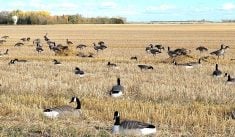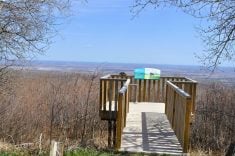Although snow still covers the ground, it’s time to start planning summer day trips.
If you’re interested in Manitoba’s history and beautiful scenery, you might want to consider St. Andrew’s Anglican Church, commonly known as St. Andrew’s-on-the-Red, on the west side of the Red River.
The parish was established by Reverend W. Cockran in 1828, and is only five years shy of its 200th anniversary. The first church was built two years later. A small wooden structure, it was only 15.8 metres by seven metres in size, with a thatched roof.
Read Also

Your best (and easiest) holiday dainty tray
Make-ahead recipes, store-bought goodies and co-operation with friends and family: Here’s how to throw together a stunning, low-stress tray.
It was originally called “the church at the rapids,” but after construction of the downstream dam at Lockport, water levels on the Red River rose. Today the rapids are no longer visible, and visitors may be surprised that they existed at all and were called “the grand rapids.”
Work on the present stone church was started in 1845 and completed in 1849. Designed by Cockran, it was built from locally quarried limestone a few kilometres to the north. The stones were hauled by sledge on the Red River over the winter.
The church became the centre of missionary activity in what was then called Rupert’s Land. It became the worship place for retired employees of the Hudson’s Bay Company and their families, many of whom are buried in the cemetery behind the church. It is the oldest stone church in Western Canada still in active use.
The building’s form is fairly simple, with thick stone walls, small windows and a full wooden steeple. The bell tower has become a Red River landmark.
The church and nearby rectory are both national historic sites, with the church also classed as a provincial heritage site.

As a working church, St. Andrew’s is only open on certain days, and was not open when I visited, but according to the internet, many original fixtures remain inside. Above the altar, for example, is a beautiful stained glass window, installed sometime between 1875 and 1884 in memory of Cockran.
Since the 1930s, a number of major repairs have been done, including a new foundation in the ‘80s. However, much of the interior is unchanged, except for carpeting and pews. The kneelers are still covered with buffalo hide.

A walk around the adjacent cemetery is interesting and informative. Engravings on the oldest gravestones, many of them on the southeast side of the church, have largely fallen prey to time, although the occasional date in the 1800s can be made out. A sign on the grounds indicates there are more than 2,000 unmarked graves.
A stone wall edges the cemetery facing the river, while a military commemorative arch lists the names of soldiers killed during the First World War.
St. Andrew’s Rectory, just across the road, was built for Cockran between 1852 and 1854, and was one of the first stone houses in the Red River Settlement. Church ministers lived in it until 1928, after which it had various uses, sometimes as a private home.
In the 1960s, the rectory was turned over to Parks Canada and has since been restored to what it would have looked like during its early use, using the original stones when possible. The rectory is open to the public from May to September, allowing visitors even if the church is closed.
History buffs will be interested in the informative panels both inside the rectory and outside on the grounds. These include details of the geology of the region as well as the history of First Nations peoples, the early Hudson Bay Company employees and other settlers. The grounds also have a rectory garden and a variety of early farming implements.
Several rooms inside display typical pioneer artifacts. A buffalo robe, a Hudson Bay Company blanket and a spinning wheel are some of the items of note. The Red River Ancestry Genealogy Centre is on the second floor.
More information on the site is available online.















